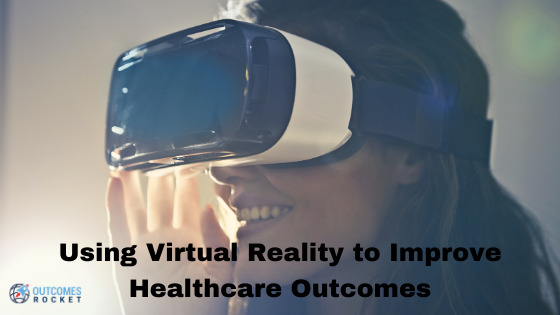
Virtual reality is finding new applications in healthcare, especially in the field of pain management.
Last year, a study built on previous work conducted by Brennan Spiegel, MD, MSHS, director of Cedars-Sinai’s Health Service Research, was published in PLOS|ONE.1 The study was conducted among 120 participants who suffered a variety of ailments including orthopedic complications, gastrointestinal diseases, and cancer. One cohort was given virtual reality (VR) therapy with a variety of distracting, relaxing, and meditative experiences, while the control group was instructed to tune in to guided-relaxation provided via TV. Results demonstrated that patients who were given VR goggles showed statistically significant improvements in pain compared to the control group provided guided-relaxation on TV.
This study among a growing amount of studies and clinical trials shows that VR can be an effective tool in reducing pain using a non-addictive, drug-free treatment for people with different pain conditions.
Given the potential efficacy of VR as a non-pharmacologic alternative for chronic pain management, companies are exploring VR to further improve the patient experience and outcomes.
One company that stands out due to its depth in research and partnership across many healthcare providers is AppliedVR. AppliedVR created the first VR care platform exclusively for healthcare that offers validated content to help patients cope with stress and anxiety.
I decided to interview Everett Crosland, SVP at AppliedVR to know how VR is changing things in healthcare and what his company is doing to add value to the healthcare ecosystem.
When asked about his company, Everett explained that AppliedVR is currently scaling a wellness product in hospitals across the country. While AppliedVR does not make medical claims on their wellness system because it has not been reviewed or cleared by FDA for medical use, AppliedVR is in the process of developing clinical evidence to support FDA submission and review of virtual reality medical devices targeting chronic pain, acute pain, and anxiety.
Everett explained that AppliedVR is selling its wellness system into emergency departments, labor and delivery departments, and for use in post-op recovery to help patients cope with pain and anxiety. Concurrently, AppliedVR is conducting clinical randomized controlled studies at Cleveland Clinic and Geisinger to study pain reduction, opioid-sparing, and the cost-savings that can be realized from using VR as part of the standard of care in pain treatment.
“I think our approach is relatively unique in that we have a really broad base of data that we’re pulling from, so we sell into over 250 hospitals across the country. We sell it to seven different countries.” Everett shared.
Having an incredibly large amount of data to mine for clinical signal helps. It leverages AppliedVR over other software companies that offer VR experience.
Stakeholders across the country are taking action to appropriately replace opioids with non-addictive solutions. Leading the hospital sector, California Hospital Compare, has listed virtual reality for pain management as one way for hospitals in the state to receive the Opioid Safe designation. More than a majority of patients prefer a non-opioid non-pharmacologic pain management regimen as a virtual reality offering. “Clearly, we fit the bill. We also have a value prop for health systems and physicians in a variety of different settings and citing the emergency department. A lot of times there’s high anxiety in that setting. And you can imagine that a patient with co-morbidities and who’s on an average of six to 11 different drugs when they come through the door, adding another drug such as a benzo can complicate your workstream and workflow” They’re carefully considering all the comorbidities and the realities of the healthcare setting to ensure the technology adequately addresses pain in the environment patients will use the VR device.
Virtual Reality is able to alleviate pain without opioids as well as improve workflow efficiency for patients while cutting costs. These valuable areas of improvement present a great opportunity for the application of the virtual reality platform AppliedVR has introduced to the market. “And so if you’re able to introduce a non-pharmacologic solution that helps patients cope with their anxiety and pain in that setting, then you’re likely to improve efficiencies as well so we can go through multiple different settings. But that’s just one example where we think through our value prop in terms of what we’re offering the patient, what we’re offering the physician in terms of their workflow efficiency and then what we’re offering health systems in terms of their ability to provide value to patients and improve the cost structure that they obviously think about on a day to day basis.”
As one of the pioneering companies to produce VR for healthcare, Everett states that his company has the responsibility to get it right and lay the groundwork to provide the infrastructure and appropriate clinical evidence to ensure VR is safe, effective, and accessible by the patients that need it.
“I think we’re setting the tone and that’s one of the most exciting parts of building an industry here is (and probably one of most anxiety-inducing parts of building an industry) as it is trying to get it right when there’s not a lot of precedents for us to reference.”
At the end of the interview, I asked Everett to share a closing thought. His call to action is “to seriously consider how virtual reality can play a role in improving care for patients without disrupting workflows. Appropriately accelerating adoption of clinically validated technologies will help patients and advance care.”
I agree. We have a wide array of digital solutions available for more exploration and possibly better applications to healthcare. You can always find one thing you can improve that will also benefit other people in the healthcare space. It is exciting to hear about the numerous areas AppliedVR is working on to bring VR into the mainstream of healthcare including; broadening indications, moving forward with clinical studies and honing in on the core indications. AppliedVR is also working to improve the patient experience and gain buy-in from payers and providers to adopt this game-changing technology for pain management. If you end up needing surgery for some reason or another, perhaps you’ll be greeted with the option to use VR for your pain management, thanks to AppliedVR.
1https://www.cedars-sinai.org/newsroom/new-study-shows-value-of-virtual-reality-for-pain-management/
According to the 2020 Centers for Disease Control and Prevention report, roughly 34.2 million Americans have diabetes,...
Read MoreAs a farmer, Rod was used to long days. He worked 18 hours a day, 7 days...
Read MoreWith investors receiving hundreds of pitch decks every year, how do you create a compelling presentation that...
Read More
Brittany Busse Co-Founder, President, and Chief Medical Officer at
ViTelHealth


Stephen Thorne Founder and CEO at
Pacific Dental Services

Keith Carlson Nurse Career Coach